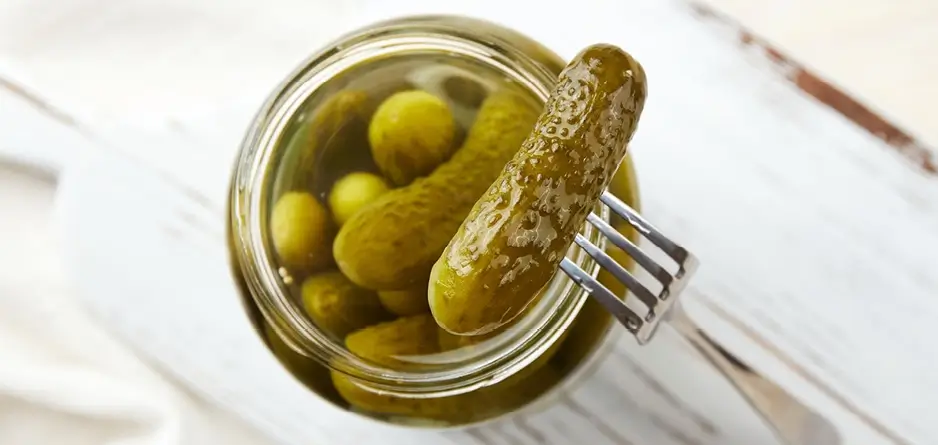The Pros and Cons of Using Pickle Juice for Muscle Cramps

Area
In short…
- Pickle juice may provide rapid relief for muscle cramps by triggering a neural reflex, but it does not address underlying causes such as electrolyte imbalances or poor circulation.
- Crampeze offers a long-term solution with magnesium, cramp bark, and ginkgo biloba to relax muscles, improve circulation, and prevent recurring cramps.
- A holistic approach is key—staying hydrated, maintaining a balanced diet, stretching regularly, and using effective supplements like Crampeze can help manage and prevent cramps.
For years, athletes and fitness enthusiasts have turned to pickle juice as a remedy for muscle and leg cramps. This briny concoction, once relegated to the back of the fridge, has increased in popularity as a potential remedy for leg cramps. But does it truly work? In this article, we explore the science behind muscle cramps, the composition of pickle juice, the potential ways it may offer relief, and consider alternative approaches to managing muscle cramps.
What Are Muscle Cramps?
Muscle cramps are sudden, involuntary contractions that can cause discomfort and disrupt daily activities. They often occur in the legs, especially in the calves, and can last for a few seconds to several minutes. These cramps can affect anyone, from professional athletes to those leading sedentary lifestyles.
Historically, cramps were attributed to dehydration or an electrolyte imbalance. However, research shows that cramps can occur even in well-hydrated individuals with balanced electrolyte levels. This has led to alternative theories, such as neuromuscular fatigue—prolonged muscle activity disrupting the balance of signals between the brain and muscles.
Learn more about leg cramps.
Why Pickle Juice?
Pickle juice has earned a reputation for its ability to relieve cramps quickly. Some athletes claim near-instant relief after consuming small amounts. Its appeal lies in the idea that it works faster than hydration or electrolyte replacement. But why?
Key Components of Pickle Juice
- Sodium: Essential for muscle function, sodium supports nerve impulse transmission and muscle contraction.
- Acetic Acid: Found in vinegar, it may trigger a neural reflex that halts cramping.
- Electrolytes: Though present in smaller amounts compared to sports drinks, potassium and magnesium may contribute to muscle function.
The most significant factor is sodium. A 30ml serving of pickle juice contains around 190-200mg of sodium, making it a concentrated source of this vital mineral.
The Science Behind Pickle Juice
Several studies suggest that pickle juice can relieve cramps quickly. One notable study published in Medicine & Science in Sports & Exercise found that 80ml of pickle juice alleviated cramps within 85 seconds too fast for electrolytes to be absorbed into the bloodstream. This led researchers to hypothesise that pickle juice triggers a neural reflex when it contacts the back of the throat, calming overactive neurons responsible for cramping.
Subsequent studies reinforced this idea, suggesting that pickle juice’s effect is more neurological than metabolic. While this makes it an intriguing quick fix, it doesn’t address the root causes of cramps.
Limitations of Pickle Juice
- Short-Term Relief: Pickle juice may work quickly but doesn’t prevent future cramps.
- Taste: The strong, sour flavour can be unappealing.
- Not Comprehensive: It lacks the broad nutritional support needed for sustained muscle health.
Alternative Solutions: Crampeze
For a comprehensive approach to muscle cramp relief, consider Crampeze. Unlike pickle juice, Crampeze targets the underlying causes of cramps and offers long-term benefits.
Key Benefits of Crampeze
- Magnesium and Cramp Bark: Magnesium relaxes muscles, while cramp bark provides additional relief.
- Improved Circulation: Ginkgo Biloba enhances blood flow, reducing cramp frequency.
- Safe for Daily Use: Ideal for chronic cramp sufferers, Crampeze is formulated for long-term support.
Practical Tips for Managing Cramps
While pickle juice and Crampeze can provide relief, a holistic approach is essential. Here’s what you can do:
- Stay Hydrated: Drink water consistently throughout the day.
- Balanced Diet: Ensure adequate intake of magnesium, potassium, and calcium. Here are some foods rich in magnesium.
- Stretch Regularly: Stretch muscles prone to cramping to improve flexibility.
- Warm-Up and Cool-Down: Prepare muscles before exercise and allow recovery time afterward. Discover how to prevent leg cramps during exercise.
- Gradual Progression: Avoid sudden increases in activity intensity or duration.
When to Choose Crampeze
For those experiencing frequent or chronic cramps, Crampeze is a superior option. Our multi-ingredient formula addresses not just the symptoms but also the root causes, providing long-lasting relief. Additionally, it’s convenient, easy to use, and doesn’t leave a sour taste in your mouth.
Pickle juice’s rapid relief makes it an interesting remedy, but it’s not a complete solution. For those seeking sustained relief and prevention, Crampeze offers a scientifically-backed alternative that promotes overall muscle health. Whether you’re an athlete, a busy professional, or someone looking for restful nights, Crampeze provides the support you need.
Choose a solution that works for your lifestyle. With Crampeze, you can enjoy active days and peaceful nights—without the sour aftertaste.







